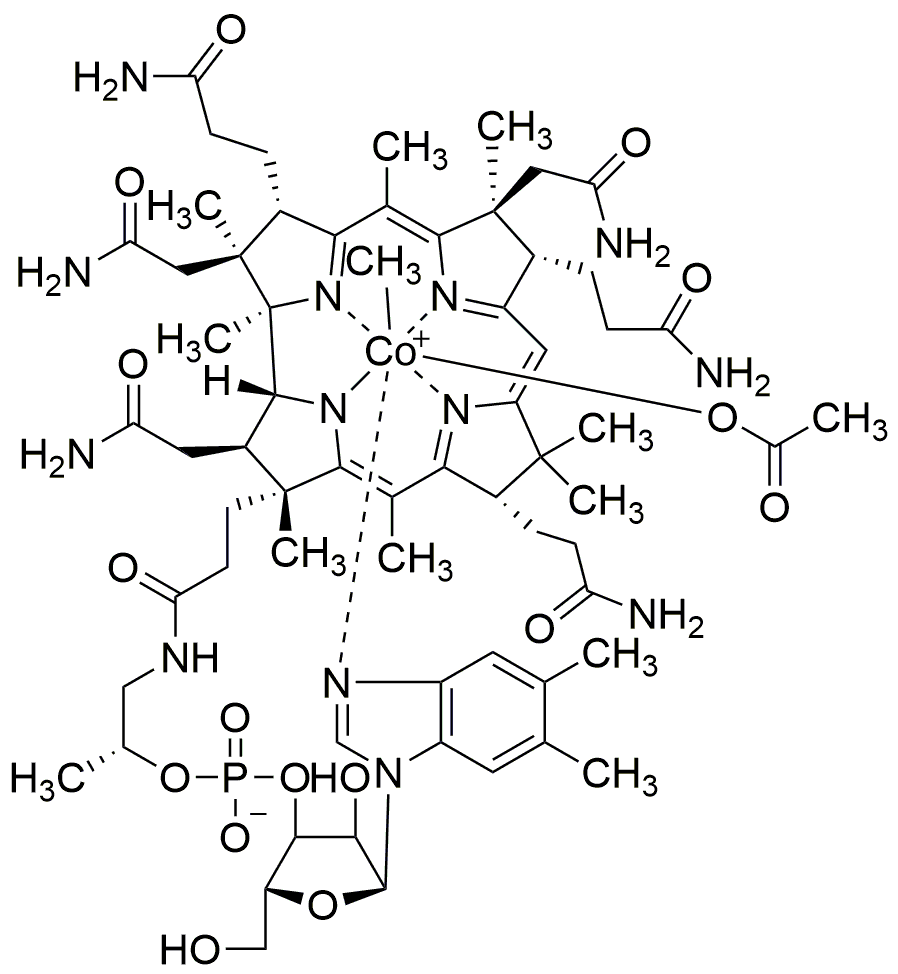Hydroxocobalamin acetate is widely utilized in research focused on:
- Vitamin B12 Supplementation: This compound serves as a potent form of Vitamin B12, helping to treat deficiencies in patients, particularly in those with absorption issues or dietary restrictions.
- Medical Treatments for Cyanide Poisoning: It is used as an antidote for cyanide poisoning, effectively binding to cyanide ions and facilitating their excretion from the body, which is crucial in emergency medicine.
- Research in Neurology: Hydroxocobalamin acetate is being studied for its potential neuroprotective effects, making it relevant in the development of treatments for neurodegenerative diseases.
- Cosmetic Applications: Due to its antioxidant properties, it is incorporated into skincare products to promote skin health and combat signs of aging, appealing to the beauty industry.
- Food Fortification: The compound is also used to fortify food products with Vitamin B12, addressing nutritional deficiencies in populations with limited access to natural sources of this vitamin.
General Information
Properties
Safety and Regulations
Applications
Hydroxocobalamin acetate is widely utilized in research focused on:
- Vitamin B12 Supplementation: This compound serves as a potent form of Vitamin B12, helping to treat deficiencies in patients, particularly in those with absorption issues or dietary restrictions.
- Medical Treatments for Cyanide Poisoning: It is used as an antidote for cyanide poisoning, effectively binding to cyanide ions and facilitating their excretion from the body, which is crucial in emergency medicine.
- Research in Neurology: Hydroxocobalamin acetate is being studied for its potential neuroprotective effects, making it relevant in the development of treatments for neurodegenerative diseases.
- Cosmetic Applications: Due to its antioxidant properties, it is incorporated into skincare products to promote skin health and combat signs of aging, appealing to the beauty industry.
- Food Fortification: The compound is also used to fortify food products with Vitamin B12, addressing nutritional deficiencies in populations with limited access to natural sources of this vitamin.
Documents
Safety Data Sheets (SDS)
The SDS provides comprehensive safety information on handling, storage, and disposal of the product.
Product Specification (PS)
The PS provides a comprehensive breakdown of the product’s properties, including chemical composition, physical state, purity, and storage requirements. It also details acceptable quality ranges and the product's intended applications.
Certificates of Analysis (COA)
Search for Certificates of Analysis (COA) by entering the products Lot Number. Lot and Batch Numbers can be found on a product’s label following the words ‘Lot’ or ‘Batch’.
Numéro de catalogue
Numéro de lot/série
Certificates Of Origin (COO)
This COO confirms the country where the product was manufactured, and also details the materials and components used in it and whether it is derived from natural, synthetic, or other specific sources. This certificate may be required for customs, trade, and regulatory compliance.
Numéro de catalogue
Numéro de lot/série
Safety Data Sheets (SDS)
The SDS provides comprehensive safety information on handling, storage, and disposal of the product.
DownloadProduct Specification (PS)
The PS provides a comprehensive breakdown of the product’s properties, including chemical composition, physical state, purity, and storage requirements. It also details acceptable quality ranges and the product's intended applications.
DownloadCertificates of Analysis (COA)
Search for Certificates of Analysis (COA) by entering the products Lot Number. Lot and Batch Numbers can be found on a product’s label following the words ‘Lot’ or ‘Batch’.
Numéro de catalogue
Numéro de lot/série
Certificates Of Origin (COO)
This COO confirms the country where the product was manufactured, and also details the materials and components used in it and whether it is derived from natural, synthetic, or other specific sources. This certificate may be required for customs, trade, and regulatory compliance.


